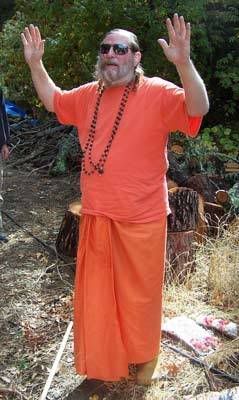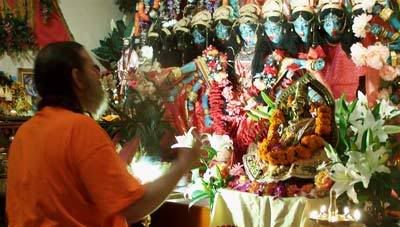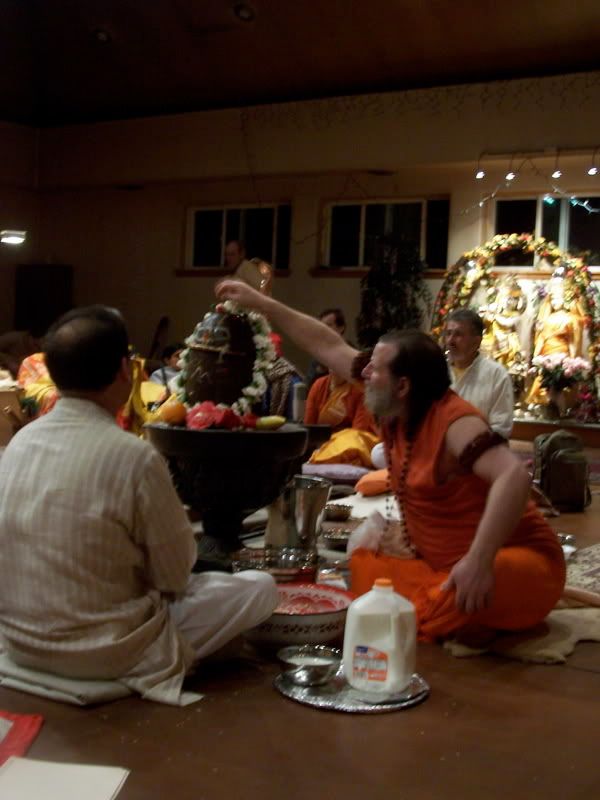
Photo of the week – Nov 9 – Nov 15, 2007
(Picture taken October 2007 at Devi Mandir, Napa, CA)
Take Diwali blessings to all.
Temple of Divine Mother

Photo of the week – Nov 9 – Nov 15, 2007
(Picture taken October 2007 at Devi Mandir, Napa, CA)
Take Diwali blessings to all.

Photo of the week – Oct 26 – Nov 1 2007
(Picture taken Oct 20, Devi Mandir, Lakshmi Puja celebration)
Check out our new weekly blogs.
~~OM~~
I want to tell you a story, if you don’t mind. There were three robbers, three thieves, who came upon a man in a lonely place in the forest. And the first thief said, “This guy is of no use for us, let’s kill him and take all his stuff.” And the second robber said, “There’s no need to kill him, lets just tie him up, bind him tightly, throw him in a ditch and take all his stuff.”
And that’s what they did. They threw him in the ditch, they tied him all up, they bound him, they stole all his goods and possessions and they made off.
The third thief walked down the path some way, and he started to feel very much remorseful. He started to think, “that poor guy is lying in a ditch all battered and bruised and bound, let me go back and help him.� And that’s what he did, he went to find the victim, and he attended to his wounds, and he unbound him. And he put him on his own horse and led him out of the forest towards his own village.
And the victim said to him, “You have been so kind to me, please come to my village and come to my house, and let me demonstrate my appreciation to you.” And the thief said to him, “I can’t go to your village.” “Why not?” “Well, the police are going to ask me why I was with the robbers in the first place.” And he disappeared. He ran away.
Now the first thief was tama guna. He says, “This guy is of no use for us, let’s just kill him.” The second thief was raja guna. He said, “No need to kill him, just tie him all up, bind him securely, throw him in the samsara, in the ocean of worldliness, where he will have all kinds of miseries.” The third thief was sattva. He says, “No, let me attend to your wounds, let me free you, let me show you the way to go home. But, I can’t go into your village. I can’t go to your house because I too am a thief.”
Sattva only shows the way to go home, he can’t go home with you. Sattva still binds you to the world in activity. To go into the house you have to be nirguna, without any quality. Not trying to do good, not trying to do evil, not trying to do anything. You become nirguna, and then you can go home.
~~OM~~
Harischandra was cursed by Vishwamitra. And Harischandra promised to deliver his son to Varuna, and he didn’t do it. And he was cursed, and he became so pained by the curse that he called all the Gurus and said, “Show me a way out. What shall I do?”
And the Gurus said, “There are five types of children. There is one begotten by the mother and father. There’s an adopted son. There’s one who is won as the spoils of war. There’s one who is attained through initiation, who becomes a child of the Guru, a member of the Guru’s family. And there is one who is bought and paid for, and sold by his parents. There are five kinds of children. So therefore king, you’ve got to sacrifice your son, go out in the kingdom and buy a son.”
The king said, “Excellent idea. Captain of the guard, go out in the kingdom and announce to anyone who is in dire straits if they want to sell their child, the king is purchasing. Name your price, I just can’t stand this pain any longer.” Now there was a poor brahmin named Ajigartha. And Ajigartha had three sons. And he said, “This poverty is so debilitating. I can’t feed my children. Better for me to sell one of the sons so that I can feed the other two. I take your offer.”
And then Ajigartha thought. He thought, “My oldest son is responsible to perform my funeral ceremony when I leave this earthly plane. So I can’t sell him. My youngest son is so innocent, I can’t sell him. So, I’m selling the middle son (whose name was Sunahshepa).”
Now the time for the sacrifice came. All the brahmins, all the Rishis, all the Gurus were sitting in the assembly and they bound Sunahshepa to the sacrificial pillar. And the executioner raised his sword above, and the child was calling so piteously. He said, “Please don’t slay me. I’m innocent, I didn’t do anything wrong. It’s the king’s duty to protect his citizens, I’m a citizen. Why would you slay an innocent citizen to protect your own self, for your own comfort? Is this the dharma of a king?”
The executioner said, “King, I’m putting down my sword, I can’t execute this child. It’s against my dharma as an executioner.” The brahmin father Ajigartha said, “King, double your payment and I’ll do it myself.” And all the Rishis, and all the brahmins, and all the Muni’s they said, “Booooooo!!!” And Ajigartha said, “It’s easy for you to condemn me, but nobody knows what the pains of poverty are really like.”
The father picked up the sword, the king agreed. The father raised the sword over the child and Vishwamitra stood up. Vishwamitra went over to Sunahshepa and he said, “I’m giving you initiation in the Bandhan Mukta Shukta, It’s in the first adhyaya of Rigveda. And this will free you from the bonds, it will liberate you from all bondage.”
Sunahshepa began to repeat after Vishwamitra, “Namo Mahabyo Namo Arbakebyyo . . .â€� I bow to the Seers of past, I bow to the Seers of the present, I bow to the Seers of the future, I bow to all the unknown Seers, I bow to all the Divine beings everywhere, release me from bondage. And with that Varuna appeared and said, “The debt is paid, release the child.”
And so Shunahshepa was freed. And Sunahshepa said to the assembly of Rishis, “Now that I am free, who is my father?” And some said, “Go home with Ajigartha, he bought you.” And some said, “No, the king paid for you, so go home with the king.” Then Vasishta stood up and said, “Go home with Vishwamitra, he is your true father, he gave you initiation in the mantra that freed you from all bondage.”
And that was the story of the Muktan Bandhan Shukta.
~~OM~~
There is the story of the farmer who heard the pundit discoursing on Gita in Sanskrit. The farmer was sitting in the back of the temple crying and crying, and the pundit went on and on and on, as pundits do. And at the end of his discourse, the hall was emptied, everyone went home, and the farmer was still sitting there crying and crying and crying.
And the pundit went up to the farmer and said, “Hey farmer, you’re obviously not a Sanskrit scholar, you probably didn’t understand a word that I said, how come you are crying?” And the farmer replied, “Your absolutely right Punditji. I didn’t understand one word that you said, but as you were speaking I saw Krishna standing on the chariot delivering the same discourse to Arjuna, and I couldn’t hold back my tears because the sight was so beautiful.”
~~OM~~
Guru Gita: Satsang with Shree Maa and Swamiji
In the following profound and elevating conversation, Shree Maa and Swamiji translate and discuss a Bengali commentary on the Guru Gita.
Mother is translating from a book by Nirmalananda, who is a disciple of Swami Pranavanandaji from Bharat Seva Ashram.
Who is the Respected Guru and what kind of behavior does the Guru exemplify? What is the Guru’s intrinsic nature and what is the principle of the Guru?
Who is able to take refuge in the Guru and what is the effect of taking refuge in Guru?
What is seva to the Guru, what is an offering to the Guru, what is the song of the Guru, and what is the discipline of a disciple?
What is the highest fruit of devotion to Guru?
The answers to all these questions are found in the scripture called Guru Gita.
Commentaries on Sri Guru Gita come from the Vishvasaara Tantra. These are expansions of the Guru Gita. Also people speak of Rudrayamal Tantra. All Tantras speak of the highest principle of the Guru.
In both the Vedas and Vedanta, the position of the Guru is held in very high regard. But in the Tantra scriptures, they speak of the Guru’s position as being the very highest. In the path of Tantra, the principle of Guru is the highest principle of all.
Guru is both the Supreme Divinity with form and without form.
The Guru is Brahma, Vishnu and Maheswar. The Respected Guru is both the motivation for the highest truth and the attainment and realization of the highest truth. These are illuminated in all of the verses contained in the Guru Gita.
The foremost principle and discussion of the highest importance has been given by Sada Shiva. His first student was Parvati.
Guru Gita informs us by which sadhana, by what means, can someone who wears a body attain success.
Without a doubt, Shiva has illuminated these questions in this scripture. The path of the Guru is the king of all dharmas (king of all ideals of perfection – the Supreme). In order to attain prasad (consecrated offering) from the Guru, your birth, your past, your karma (what kind of activities you perform) are not required subjects. The ignorant, the lazy and those steeped in darkness (tamas) will not proceed in this path. They are not capable of achieving the understanding of the wisdom of the principles. They don’t have wisdom or desire knowledge of liberation.
It is incumbent upon all those who take refuge in the Guru to do so with their body, mind and speech.
Seva (selfless service as an expression of love) to the Guru, Puja, aaradhana is a disciple’s sadhana. Giving pleasure to the Guru is your sadhana, your worship.
Whoever is able to do atma samarpan (surrender of his or her own soul in equilibrium) to the Sri Guru’s Feet – giving up all their attachment – this is samadhi and siddhi (attainment of perfection). This is the path of the Guru.
The Guru is not a human being. The Guru is the Supreme Divinity made manifest. Because of this, we cannot look at our Guru as just a human being. This Guru principle is united with all pure qualities, beautiful attributes, the greatness of all purity. This is the authority that comes through the Guru.
If you can perceive these qualities in your Guru, you will not think of your Guru as a mere human being. The Guru is Bhagavan (Supreme Divinity).
All the qualities and all the attitudes, all the energies and all that is Infinite or eternal, all the wisdom that is inculcated – all these qualities are only reflected in God. That Godliness is reflected in the Guru. So we should not think of the Guru as a human being. We would think of the Guru as the emblem or representative of Supreme Divinity.
Where there is atma samarpan, the disciple becomes a mirror and there is union between Guru and disciple in a great radiant light. When there is a transfer of energy from Guru to disciple and surrender, there is a light that is incomparable to anything you can see with worldly eyes.
Trailinga Swami once locked himself in His room for three days. His disciple was very worried and wanted to see Swamiji. He went to the door and banged and banged and banged. Trailinga Swamiji said ‘Who are you?”
The disciple was full of his own ego self, and replied, “I am so and so”. He felt he was a real disciple, but he was not at that moment. There was no response from within. On the second day, the disciple went again and banged on the door and received the same question. Again he answered, “I am so and so”. Nothing happened. On third day, the disciple thought deeply and cried, “Why is the Guru doing this to me?”
Again he knocked on the door with reverence. Trailinga Swami asked, “Who are you?” The disciple replied, “You.” Trailinga Swamji opened the door.
The Guru-disciple relationship is very subtle. Atma samarpan has become a big market nowadays. The relationship between Guru and Disciple is truth. A truthful relationship means surrender. You will get everything with surrender.
Where is the individual form of God? Ishwara, God, the Supreme Soul, is everywhere, in every place. He is in the gross body, the subtle body, the modifications of the mind and unmanifest as well. How can the individual wearing a body grasp Supreme Divinity, find Him, touch Him with sensory knowledge? With our current perception, this is a very difficult issue.
There is a solution to this issue in Hindu Dharma. Scriptures say that He who understands Supreme Divinity, becomes Supreme Divinity. Who has refined the discipline of sadhana, becomes united with all the tendencies of sadhana, he understands the nature of the Supreme Divinity. That individual becomes a representative of Supreme Divinity.
A great example of that is Swamiji!!! This moment Swamiji does not need sadhana. He can go to the Himalayas and be by Himself. But to show the world, He is doing sadhana.
We are born, we learn how to walk, first we learn from our parents – how to walk, how to eat – step by step, our whole life is sadhana. In childhood we are learning how to be human. Now we are learning how to be with the soul. Without sadhana, we will never know.
The Supreme Divinity, the teacher, and the yogi who has attained divinity are all one.
The Yogi is actually a murti – the perceivable form of Supreme Divinity. All the true qualities of a Yogi are illuminated in reality.
We believe that according to the needs of the age, God Himself comes in an embodied form. That Supreme Divinity which is Infinite beyond conception takes a human form and takes birth in the mortal world.
He is undefeatable and that is the Supreme Divinity manifested amongst all the elements of existence.
When we do surrender our soul in equilibrium (atma samarpana), we receive Diksha. The first chapter of this experience is to receive a mantra in the ear, but that is only the first chapter. Om

Photo of the week of Feb 25 – Mar 3 2007
(Taken on MahaShivaratri, Feb 15 2007 in front of Yajneshwar, at Devi Mandir, Napa, CA)
Check out our weekly blogs.
Guru: The syllable Gu means darkness, Ru means light. The Supreme Divinity which destroys ignorance is verily the Guru, without a doubt.
The Guru is Brahma, the Guru is Vishnu, the Guru is Lord Mahesvara. The Guru is actually the Supreme Divinity, and all other expressions are links in the chain which bring us close to that realization.…read more